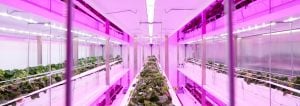In a few years, indoor (vertical) farms have become popular for producing healthy food year-round in urban environments and harsh climates. Leafy greens and herbs are the most commonly grown crops, but growers are looking to expand to a much wider variety of vegetables and fruits. In our Philips GrowWise research Center, we have been running trials on strawberries for several years. Recently we took these trials to the next level. Our goal? Develop a reference design for growing strawberries indoor, find the optimal light recipe and the best performing varieties.
At the Philips GrowWise Research Center in Eindhoven, we research all growth parameters relevant to a crop: light is obviously essential, but factors such as climate, variety choice and substrate are equally important. The idea of growing strawberries indoors was not new to us. In fact, we have been growing strawberries without daylight for over five years already. Despite some disappointments and setbacks, the results and first business case calculations proved encouraging enough to further pursue the topic and build a reference design for growing strawberries.





